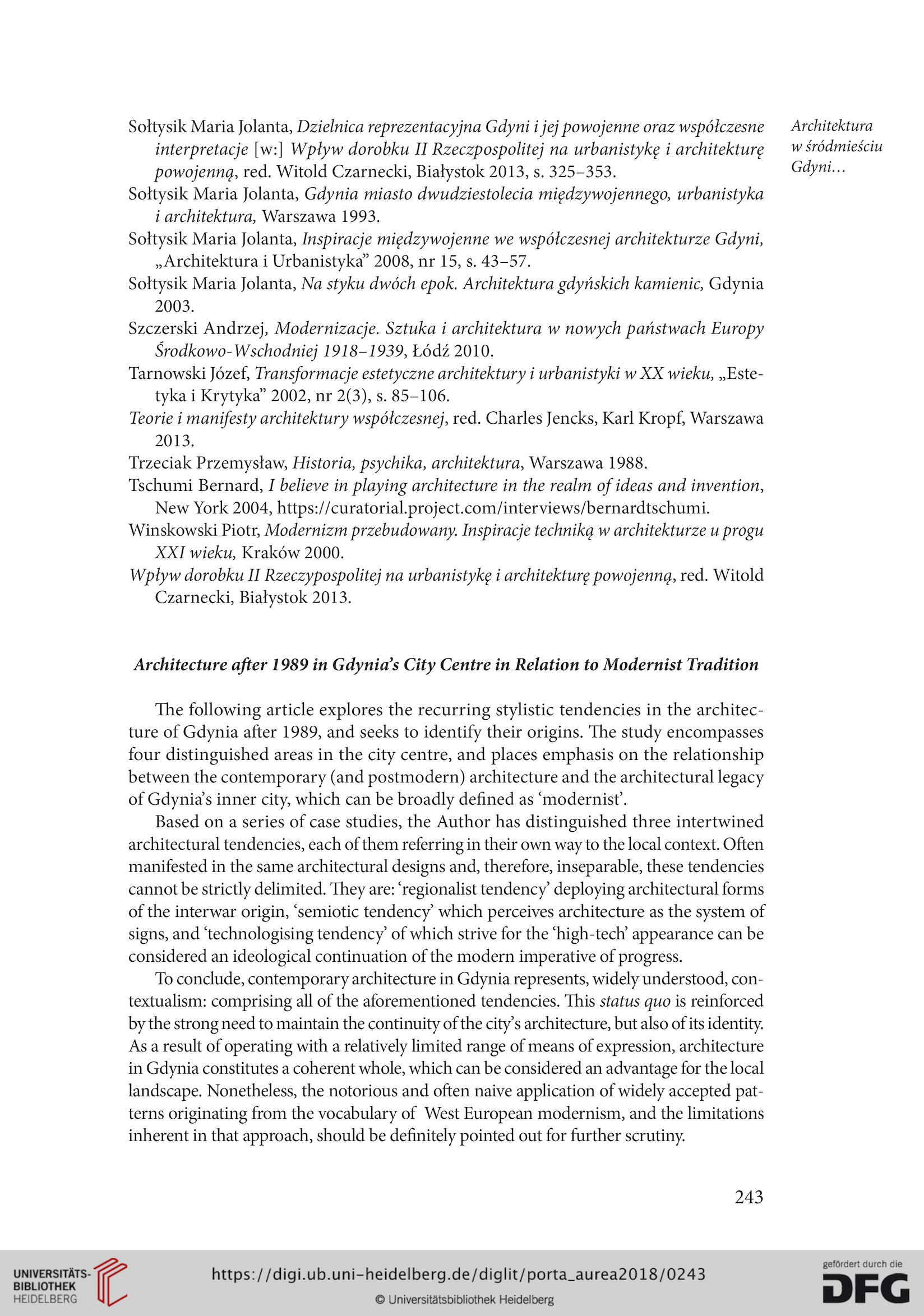Sołtysik Maria Jolanta, Dzielnica reprezentacyjna Gdyni i jej powojenne oraz współczesne
interpretacje [w:] Wpływ dorobku II Rzeczpospolitej na urbanistykę i architekturę
powojenną, red. Witold Czarnecki, Białystok 2013, s. 325-353.
Sołtysik Maria Jolanta, Gdynia miasto dwudziestolecia międzywojennego, urbanistyka
i architektura, Warszawa 1993.
Sołtysik Maria Jolanta, Inspiracje międzywojenne we współczesnej architekturze Gdyni,
„Architektura i Urbanistyka” 2008, nr 15, s. 43-57.
Sołtysik Maria Jolanta, Na styku dwóch epok. Architektura gdyńskich kamienic, Gdynia
2003.
Szczerski Andrzej, Modernizacje. Sztuka i architektura w nowych państwach Europy
Środkowo-Wschodniej 1918-1939, Łódź 2010.
Tarnowski Józef, Transformacje estetyczne architektury i urbanistyki w XX wieku, „Este-
tyka i Krytyka” 2002, nr 2(3), s. 85-106.
Teorie i manifesty architektury współczesnej, red. Charles Jencks, Karl Kropf, Warszawa
2013.
Trzeciak Przemysław, Historia, psychika, architektura, Warszawa 1988.
Tschumi Bernard, I believe in playing architecture in the realm ofideas and invention,
New York 2004, https://curatorial.project.com/interviews/bernardtschumi.
Winskowski Piotr, Modernizm przebudowany. Inspiracje techniką w architekturze u progu
XXI wieku, Kraków 2000.
Wpływ dorobku II Rzeczypospolitej na urbanistykę i architekturę powojenną, red. Witold
Czarnecki, Białystok 2013.
Architecture after 1989 in Gdy ni as City Centre in Relation to Modernist Tradition
The following article explores the recurring stylistic tendencies in the architec-
ture of Gdynia after 1989, and seeks to identify their origins. The study encompasses
four distinguished areas in the city centre, and places emphasis on the relationship
between the contemporary (and postmodern) architecture and the architectural legacy
of Gdynia’s inner city, which can be broadly defined as ‘modernist’.
Based on a series of case studies, the Author has distinguished three intertwined
architectural tendencies, each of them referring in their own way to the local context. Often
manifested in the same architectural designs and, therefore, inseparable, these tendencies
cannot be strictly delimited. They are: ‘regionalist tendency deploying architectural forms
of the interwar origin, ‘semiotic tendency which perceives architecture as the system of
signs, and ‘technologising tendency of which strive for the ‘high-tech’ appearance can be
considered an ideological continuation of the modern imperative of progress.
To conclude, contemporary architecture in Gdynia represents, widely understood, con-
textualism: comprising all of the aforementioned tendencies. This status quo is reinforced
by the strong need to maintain the continuity of the citys architecture, but also of its identity.
As a result of operating with a relatively limited rangę of means of expression, architecture
in Gdynia constitutes a coherent whole, which can be considered an advantage for the local
landscape. Nonetheless, the notorious and often naive application of widely accepted pat-
terns originating from the vocabulary of West European modernism, and the limitations
inherent in that approach, should be definitely pointed out for further scrutiny.
Architektura
w śródmieściu
Gdyni...
243
interpretacje [w:] Wpływ dorobku II Rzeczpospolitej na urbanistykę i architekturę
powojenną, red. Witold Czarnecki, Białystok 2013, s. 325-353.
Sołtysik Maria Jolanta, Gdynia miasto dwudziestolecia międzywojennego, urbanistyka
i architektura, Warszawa 1993.
Sołtysik Maria Jolanta, Inspiracje międzywojenne we współczesnej architekturze Gdyni,
„Architektura i Urbanistyka” 2008, nr 15, s. 43-57.
Sołtysik Maria Jolanta, Na styku dwóch epok. Architektura gdyńskich kamienic, Gdynia
2003.
Szczerski Andrzej, Modernizacje. Sztuka i architektura w nowych państwach Europy
Środkowo-Wschodniej 1918-1939, Łódź 2010.
Tarnowski Józef, Transformacje estetyczne architektury i urbanistyki w XX wieku, „Este-
tyka i Krytyka” 2002, nr 2(3), s. 85-106.
Teorie i manifesty architektury współczesnej, red. Charles Jencks, Karl Kropf, Warszawa
2013.
Trzeciak Przemysław, Historia, psychika, architektura, Warszawa 1988.
Tschumi Bernard, I believe in playing architecture in the realm ofideas and invention,
New York 2004, https://curatorial.project.com/interviews/bernardtschumi.
Winskowski Piotr, Modernizm przebudowany. Inspiracje techniką w architekturze u progu
XXI wieku, Kraków 2000.
Wpływ dorobku II Rzeczypospolitej na urbanistykę i architekturę powojenną, red. Witold
Czarnecki, Białystok 2013.
Architecture after 1989 in Gdy ni as City Centre in Relation to Modernist Tradition
The following article explores the recurring stylistic tendencies in the architec-
ture of Gdynia after 1989, and seeks to identify their origins. The study encompasses
four distinguished areas in the city centre, and places emphasis on the relationship
between the contemporary (and postmodern) architecture and the architectural legacy
of Gdynia’s inner city, which can be broadly defined as ‘modernist’.
Based on a series of case studies, the Author has distinguished three intertwined
architectural tendencies, each of them referring in their own way to the local context. Often
manifested in the same architectural designs and, therefore, inseparable, these tendencies
cannot be strictly delimited. They are: ‘regionalist tendency deploying architectural forms
of the interwar origin, ‘semiotic tendency which perceives architecture as the system of
signs, and ‘technologising tendency of which strive for the ‘high-tech’ appearance can be
considered an ideological continuation of the modern imperative of progress.
To conclude, contemporary architecture in Gdynia represents, widely understood, con-
textualism: comprising all of the aforementioned tendencies. This status quo is reinforced
by the strong need to maintain the continuity of the citys architecture, but also of its identity.
As a result of operating with a relatively limited rangę of means of expression, architecture
in Gdynia constitutes a coherent whole, which can be considered an advantage for the local
landscape. Nonetheless, the notorious and often naive application of widely accepted pat-
terns originating from the vocabulary of West European modernism, and the limitations
inherent in that approach, should be definitely pointed out for further scrutiny.
Architektura
w śródmieściu
Gdyni...
243




